When setting the definition for a scary movie, a multitude of sub-genres need to be considered. There’s your basic run-of-the-mill slasher film; guy with a sharp melee weapon viciously bludgeoning numerous screaming people to death for no apparent reason (“Friday the 13th,” “Halloween,” etc). There’s the made-to-feel real films (“Blair Witch Project,” “Paranormal Activity,” etc) where the viewer is given the impression that the events on screen really happened at some point in time. There’s the gross-you-out genre that consist of copious amounts of blood, gore, and just plain stomach turning play (“Arachnophobia,” every “Saw” movie).
Last but not least is the psychological horror film, and while these types tend to be rare commodities, they run the gauntlet for the best in the horror genre. The reason is simple. A truly great horror film knows the difference between startling someone…and scaring them. A startle is fun to watch. It’s tantamount to hiding behind a door and shouting boo! You get a jump out of the victim. Their stomach bottoms out. They laugh. That’s the end.
A truly great horror film will have you thinking about it long after you’ve finished watching. It puts you on edge in a darkened room at night – and in a crowded office building in the middle of the day. It can render a grown man stricken with a pit of unidentifiable anxiety as he lies motionless in bed, second guessing that late night glass of water, as he desperately tries to shake off the urges of his bladder (like I was last night). It causes developed biceps to become scattered with goose bumps. It’s truly a frightening ordeal.
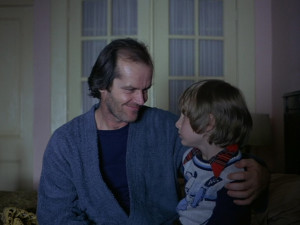
The most terrifying movie I have seen – and my all time favorite horror movie – is Stanley Kubrick’s 1980 classic “The Shining.” The film revolutionized the horror genre of the time, which was still reeling from the mindless scream and slasher films of the ’70s, by displaying the psychological, built up advancing anticipation of horror more prevalent today.
The movie is based on the novel by Stephen King, himself one of my favorite authors and my greatest inspiration for horror writing. King is well known to have given disparaging remarks about Kubrick’s film, calling it the worst adaptation of any of his novels.
As a writer I can concur. The movie is never as good as the book. But I have never read the novel, so my frame of comparison begins and ends with Kubrick’s masterpiece, which brings about a suspenseful terror unparalleled in any other movie.
Writer and recovering alcoholic Jack Torrance (Jack Nicholson) takes a job at a secluded Colorado Resort called the Overlook Hotel working what is the equivalent of the graveyard shift, watching the boiler over the long winter while the resort is closed to the public. Torrance seizes the opportunity for isolation to work on a new book. Accompanying him are his wife Wendy (Shelley Duvall) and six-year-old son Danny (Danny Lloyd).
Before starting the job, Jack is forewarned by the hotel manager Stuart Ullman (Barry Nelson) that one of the previous caretakers, a man named Charles Grady, went insane due to (what they believe to be) cabin fever from the isolation and murdered his wife and two young daughters with an axe before killing himself. Jack assures Ullman “that’s not going to happen with me.”
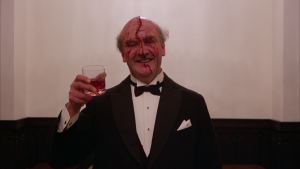 The Torrance family arrives at the stunningly magnificent Overlook Hotel (which of course was built on an Indian burial ground) and Ullman gives them a tour. The hotel chef Dick Hallorann (Scatman Crothers) quickly bonds with Danny when he discovers they each share the unique ability to communicate telepathically (he refers to this as the ability to “shine”).
The Torrance family arrives at the stunningly magnificent Overlook Hotel (which of course was built on an Indian burial ground) and Ullman gives them a tour. The hotel chef Dick Hallorann (Scatman Crothers) quickly bonds with Danny when he discovers they each share the unique ability to communicate telepathically (he refers to this as the ability to “shine”).
Quickly, Danny begins to see the haunting images of the hotels grisly past, including the unnerving apparitions of the Grady girls, holding hands and beckoning him to come and play with them “forever and ever, and ever.” Danny takes refuge by communicating with his imaginary friend Tony, who has already advised him that the hotel is not safe.
As time passes, Jack becomes irritable and aggressive towards his family, and eventually stumbles upon the resort lounge where he encounters a spectral bartender named Lloyd. Jack, who has not touched a drop of liquor since a physically abusive altercation with Danny some time ago, is quickly served a drink by Lloyd who informs him that his money is no good there – orders from the house.
As the drinks start flowing, the haunted shining of the Overlook Hotel slowly drives Jack to madness where his only victims are the only ones that are available in the secluded resort – his wife and son.
One of King’s most outspoken criticisms with the film was the use of Jack Nicholson as the primary character. King felt due to Nicholson’s prior roles the audience would be fully expecting him to go insane. That is of course, the plot of the story but Kubrick’s masterful deception and subdued creepiness should be lauded as you’ll sit on the edge of your seat plodding through the formal beginnings, just waiting. King’s critique is correct. You do know what is going to happen. From the moment Jack Nicholson appears for the first time, you know he is going to go berserk. How or what will happen remain the mystery. The ghastly images and cinematography, coupled with an evocative and creepy score will keep you thoroughly horrified from start to finish.
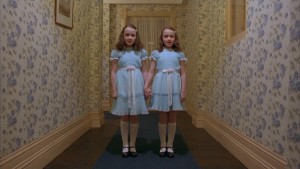 It’s tough to pinpoint a single role as the best ever in the career for an actor with a resume like Nicholson’s, but the role of Jack Torrance in “The Shining” is without a doubt, his most brilliant performance.
It’s tough to pinpoint a single role as the best ever in the career for an actor with a resume like Nicholson’s, but the role of Jack Torrance in “The Shining” is without a doubt, his most brilliant performance.
Some interesting trivia from the movie; Stanley Kubrick was able to film all of young Danny Lloyd’s scenes without the child ever being aware that he was in a horror movie. Danny Lloyd didn’t watch “The Shining” in its entirety until eleven years after it was filmed.
In the iconic scene in which Jack breaks down the bathroom door, the props department built a door that could be easily broken. However, Jack Nicholson had worked as a volunteer fire marshal and tore it apart far too easily. The props department was then forced to build a stronger door.
According to the Guinness Book of Records, the scene where Wendy was walking backwards up the stairs swinging the baseball bat was shot 127 times, which is a record for the most takes of a single scene.
The basis for the Overlook Hotel is the Stanley Hotel in Estes Park, Colorado, where King and his wife stayed. The idea for “The Shining” came about after King himself witnessed strange activity in the room they were staying – room 217 – which had long been reputed as being haunted.
Buy “The Shining.” It needs to be in your collection. You’ll want to watch it every Halloween. Forever…and ever…and ever.
– by Matt Christopher
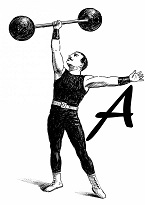

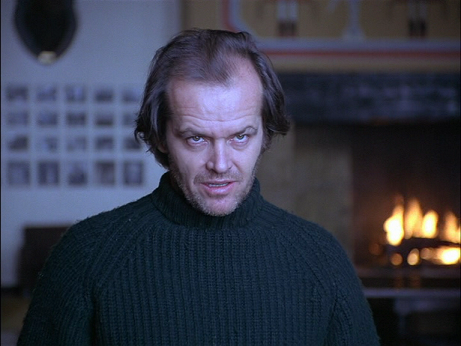
2 Comments
Pingback: » The Thing (R)
Pingback: » The Ring (PG-13)